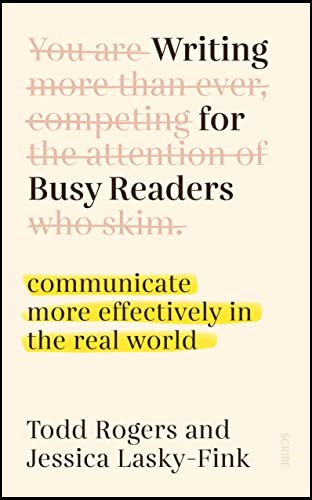We’re all busy people nowadays. We’re busy churning out reports or emails or text messages. We skim through incoming messages, reading the ‘important’ ones and disregarding the rest.
And so, we have all missed important messages or requests from time to time. Or failed to get the desired responses from our own messages. What’s the problem? It usually comes down to poor writing.
To help, authors Todd Rogers and Jessica Lanky-Fink of Harvard University have prepared some guidance for writers in our time-poor world. In their concise book Writing for Busy Readers, they outline the keys to improve communication effectiveness.
Their approach involves six principles:

Less is More. The authors show through numerous experiments, that shorter messages provoke a higher response rate than longer ones. Test yourself: if you have two emails to read; one short and one long, which do you read first? Invariably the short one. Longer messages deter readers so keep your message short, focus on the minimum of ideas and make fewer requests. On this latter point multiple requests in a message usually result in incomplete responses, so work out what’s most important and don’t overburden the reader.
Make Reading Easy. The authors suggest three rules to make writing easier to read. First, use short and common words. This includes avoiding jargon and ‘sophisticated’ words. Second, write straightforward sentences. This means writing in a logical order with all relevant words and phrases close together. And thirdly, write shorter sentences by limiting a sentence to a single idea, rather than trying to combine multiple ideas into one sentence.
Design for Easy Navigation. This principle is all about how writing is laid out so that the reader can be guided to the most important messages. The rules here include making key information immediately visible, separating distinct ideas, using headings, and using visual aids such as tables, charts and diagrams.
The fourth principle is to Use enough formatting, but no more. Highlighting, underlining, or bolding words and sentences is an effective way of directing readers to your key message. But emphasising too many messages or mixing styles can lead to more confusion than clarity.
Tell readers why they should care. Here writers need to emphasize what matters to the reader, rather than what matters to the writer. And related to this is making sure the message is targeting the right audience. For example a group email notification headed “Closure of Smithton Library” will be more effective than one headed “Notice of Library Closure”.
The sixth and final principle is Make responding easy. This includes simplifying the steps required for the reader to act, organizing key information needed for action, and minimizing the amount of attention required.
The authors have another core tip: Revise, Revise, Revise! Make sure typos and mangled grammar don’t sneak through, then check you have answered these two essential questions: “What is the most important information I want my readers to understand?” and “Have I made it easy for my readers to understand it?”
Writing for Busy Readers is an accessible book that provides simple no-nonsense advice to improve your writing effectiveness. Everyone from corporate professionals to wanna-be social media influencers to a Mom or Dad sending out their child’s birthday party invitations would benefit from following the book’s guiding principles.
The reviewer is a co-author of Court of the Grandchildren, a novel set in 2050s America.
Main image credit: Pexels via Pixabay
